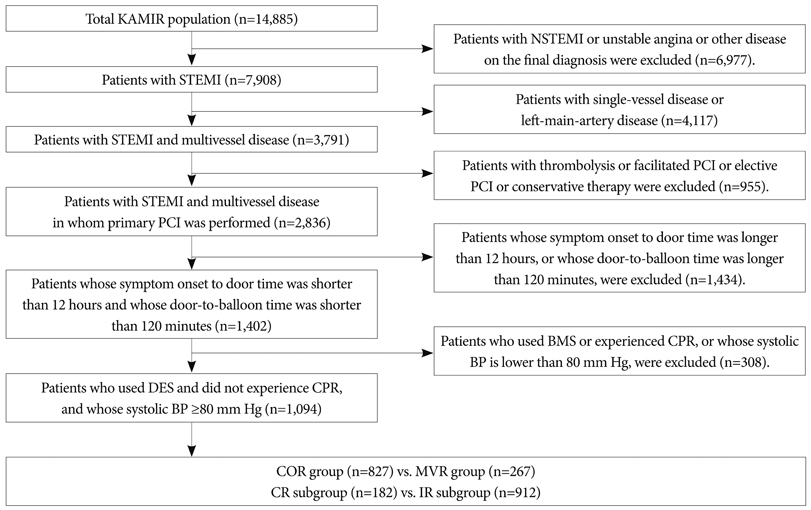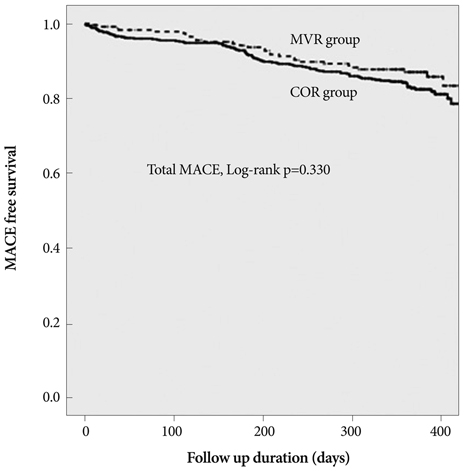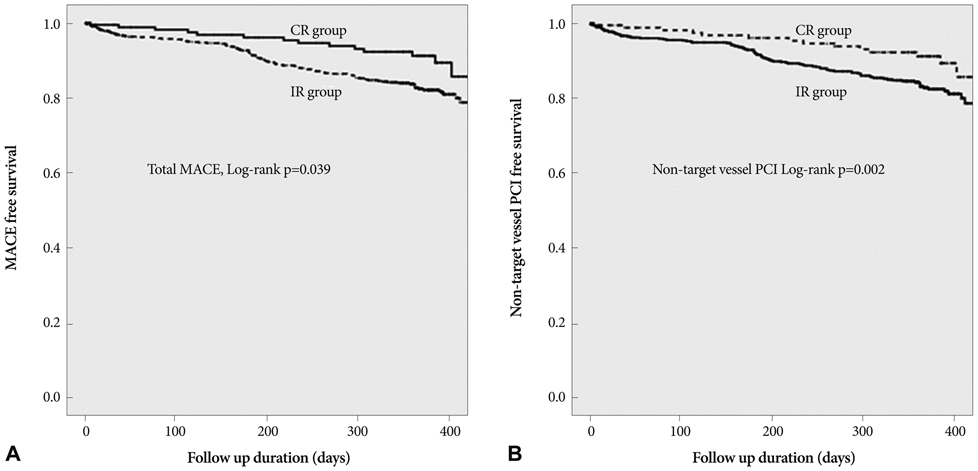Korean Circ J.
2011 Dec;41(12):718-725. 10.4070/kcj.2011.41.12.718.
Culprit-Lesion-Only Versus Multivessel Revascularization Using Drug-Eluting Stents in Patients With ST-Segment Elevation Myocardial Infarction: A Korean Acute Myocardial Infarction Registry-Based Analysis
- Affiliations
-
- 1Division of Cardiology, Department of Internal Medicine, Yeungnam University Hospital, Daegu, Korea. pjs@med.yu.ac.kr
- 2Department of Internal Medicine, Chonnam National University Medical School, Gwangju, Korea.
- 3Department of Internal Medicine, Kyungpook National University College of Medicine, Daegu, Korea.
- 4Department of Internal Medicine, Keimyung University College of Medicine, Daegu, Korea.
- 5Department of Internal Medicine, Pusan National University School of Medicine, Busan, Korea.
- 6Department of Internal Medicine, Chungnam National University College of Medicine, Daejeon, Korea.
- 7Department of Internal Medicine, Chonbuk National University College of Medicine, Jeonju, Korea.
- 8Department of Internal Medicine, Jeonju Presbyterian Medical Center, Jeonju, Korea.
- 9Department of Internal Medicine, Seoul National University College of Medicine, Seongnam, Korea.
- 10Department of Internal Medicine, Chungbuk National University College of Medicine, Cheongju, Korea.
- 11Department of Internal Medicine, Konyang University College of Medicine, Daejeon, Korea.
- 12Department of Internal Medicine, Korea University College of Medicine, Seoul, Korea.
- 13Department of Internal Medicine, Kyunghee University College of Medicine, Seoul, Korea.
- 14Department of Internal Medicine, Yonsei University Severans Hospital, Seoul, Korea.
- 15Department of Internal Medicine, Yonsei University Wonju Christian Hospital, Wonju, Korea.
- 16Department of Internal Medicine, The Catholic University of Korea Seoul St. Mary's Hospital, Seoul, Korea.
- 17Department of Internal Medicine, Asan Medical Center, University of Ulsan College of Medicine, Seoul, Korea.
- KMID: 1776247
- DOI: http://doi.org/10.4070/kcj.2011.41.12.718
Abstract
- BACKGROUND AND OBJECTIVES
In patients with ST-segment elevation myocardial infarction (STEMI) and multivessel disease, complete revascularization (CR) for non-culprit lesions is not routinely recommended. The aim of this study was to compare the clinical outcomes of multivessel compared with infarct-related artery (IRA)-only revascularization in patients undergoing primary percutaneous coronary intervention (PCI) for STEMI.
SUBJECTS AND METHODS
From the Korean Acute Myocardial Infarction Registry (KAMIR) database, 1,094 STEMI patients with multivessel disease who underwent primary PCI with drug-eluting stents were enrolled in this study. The patients were divided into two groups: culprit-vessel-only revascularization (COR, n=827) group; multivessel revascularization, including non-IRA (MVR, n=267) group. The primary endpoint of this study included major adverse cardiac events (MACEs), such as death, myocardial infarction, or target or nontarget lesion revascularization at one year.
RESULTS
There was no difference in clinical characteristics between the two groups. During the one-year follow-up, 102 (15.2%) patients in the COR group and 32 (14.2%) in the MVR group experienced at least one MACE (p=0.330). There were no differences between the two groups in terms of rates of death, myocardial infarction, or revascularization (2.1% vs. 2.0%, 0.7% vs. 0.8%, and 11.7% vs. 10.1%, respectively; p=0.822, 0.910, and 0.301, respectively). The MACE rate was higher in the incompletely revascularized patients than in the completely revascularized patients (15% vs. 9.5%, p=0.039), and the difference was attributable to a higher rate of nontarget vessel revascularization (8.6% vs. 1.8%, p=0.002).
CONCLUSION
Although multivessel angioplasty during primary PCI for STEMI did not reduce the MACE rate compared with culprit-vessel-only PCI, CR was associated with a lower rate of repeat revascularization after multivessel PCI.
MeSH Terms
Figure
Reference
-
1. Hong JS, Kang HC, Lee SH, Kim J. Long-term trend in the incidence of acute myocardial infarction in Korea: 1997-2007. Korean Circ J. 2009. 39:467–476.2. Sim DS, Kim JH, Jeong MH. Differences in clinical outcomes between patients with ST-elevation versus non-ST-elevation acute myocardial infarction in Korea. Korean Circ J. 2009. 39:297–303.3. Lee MG, Jeong MH, Ahn Y, et al. Impact of the metabolic syndrome on the clinical outcome of patients with acute ST-elevation myocardial infarction. J Korean Med Sci. 2010. 25:1456–1461.4. Goldstein JA, Demetriou D, Grines CL, Pica M, Shoukfeh M, O'Neill WW. Multiple complex coronary plaques in patients with acute myo cardial infarction. N Engl J Med. 2000. 343:915–922.5. Muller DW, Topol EJ, Ellis SG, Sigmon KN, Lee K, Califf RM. Multivessel coronary artery disease: a key predictor of short-term prognosis after reperfusion therapy for acute myocardial infarction: Thrombolysis and Angioplasty in Myocardial Infarction (TAMI) Study Group. Am Heart J. 1991. 121:1042–1049.6. Parodi G, Memisha G, Valenti R, et al. Five year outcome after primary coronary intervention for acute ST elevation myocardial infarction: results from a single centre experience. Heart. 2005. 91:1541–1544.7. Shishehbor MH, Topol EJ, Mukherjee D, et al. Outcome of multivessel coronary intervention in the contemporary percutaneous revascularization era. Am J Cardiol. 2006. 97:1585–1590.8. Ijsselmuiden AJ, Ezechiels J, Westendorp IC, et al. Complete versus culprit vessel percutaneous coronary intervention in multivessel disease: a randomized comparison. Am Heart J. 2004. 148:467–474.9. Marenzi G, Assanelli E, Campodonico J, et al. Contrast volume during primary percutaneous coronary intervention and subsequent contrast-induced nephropathy and mortality. Ann Intern Med. 2009. 150:170–177.10. Antman EM, Anbe DT, Armstrong PW, et al. ACC/AHA guidelines for the management of patients with ST-elevation myocardial infarction: a report of the American College of Cardiology/American Heart Association Task Force on Practice Guidelines (Committee to Revise the 1999 Guidelines for the Management of patients with acute myocardial infarction). J Am Coll Cardiol. 2004. 44:E1–E211.11. Smith SC Jr, Feldman TE, Hirshfeld JW Jr, et al. ACC/AHA/SCAI 2005 guideline update for percutaneous coronary intervention: a report of the American College of Cardiology/American Heart Association Task Force on Practice Guidelines (ACC/AHA/SCAI Writing Committee to Update 2001 Guidelines for Percutaneous Coronary Intervention). Circulation. 2006. 113:e166–e286.12. Politi L, Sgura F, Rossi R, et al. A randomized trial of target-vessel versus multi-vessel revascularization in ST-elevation myocardial infarction: major adverse cardiac events during long-term follow-up. Heart. 2010. 96:662–667.13. Lee KH, Jeong MH, Ahn YK, et al. Gender differences of success rate of percutaneous coronary intervention and short term cardiac events in Korea Acute Myocardial Infarction Registry. Int J Cardiol. 2008. 130:227–234.14. Kwon TG, Bae JH, Jeong MH, et al. N-terminal pro-B-type natriuretic peptide is associated with adverse short-term clinical outcomes in patients with acute ST-elevation myocardial infarction underwent primary percutaneous coronary intervention. Int J Cardiol. 2009. 133:173–178.15. Lee SR, Jeong MH, Ahn YK, et al. Clinical safety of drug-eluting stents in the Korea Acute Myocardial Infarction Registry. Circ J. 2008. 72:392–398.16. Thygesen K, Alpert JS, White HD. Universal definition of myocardial infarction. Eur Heart J. 2007. 28:2525–2538.17. Cutlip DE, Windecker S, Mehran R, et al. Clinical end point in coronary stent trials: a case for standardized definitions. Circulation. 2007. 115:2344–2351.18. Ellis SG, Roubin GS, King SB 3rd, et al. Angiographic and clinical predictors of acute closure after native vessel coronary angioplasty. Circulation. 1988. 77:372–379.19. Cavender MA, Milfort-Beland S, Roe MT, Peterson ED, Weintraub WS, Rao SV. Prevalence, predictors, and in-hospital outcomes of non-infarct artery intervention during primary percutaneous coronary intervention for ST-segment elevation myocardial infarction (from the National Cardiovascular Data Registry). Am J Cardiol. 2009. 104:507–513.20. Roe MT, Cura FA, Joski PS, et al. Initial experience with multivessel percutaneous coronary intervention during mechanical reperfusion for acute myocardial infarction. Am J Cardiol. 2001. 88:170–173.21. Corpus RA, House JA, Marso SP, et al. Multivessel percutaneous coronary intervention in patients with multivessel disease and acute myocardial infarction. Am Heart J. 2004. 148:493–500.22. Kornowski R, Mehran R, Satler LF, et al. Procedural results and late clinical outcomes following multivessel coronary stenting. J Am Coll Cardiol. 1999. 33:420–426.23. Moussa I, Reimers B, Moses J, et al. Long-term angiographic and clinical outcome of patients undergoing multivessel coronary stenting. Circulation. 1997. 96:3873–3879.24. Brener SJ, Milford-Beland S, Roe MT, Bhatt DL, Weintraub WS, Brindis RG. Culprit-only or multivessel revascularization in patients with acute coronary syndromes: an American College of Cardiology National Cardiovascular Database Registry report. Am Heart J. 2008. 155:140–146.25. Kim MC, Jeong MH, Ahn Y, et al. What is optimal revascularization strategy in patients with multivessel coronary artery disease in non-ST-elevation myocardial infarction? Multivessel or culprit-only revascularization. Int J Cardiol. 2011. [Epub ahead of print].
- Full Text Links
- Actions
-
Cited
- CITED
-
- Close
- Share
- Similar articles
-
- Complete Versus Culprit-Only Revascularization for ST-Segment Elevation Myocardial Infarction and Multivessel Disease in the 2(nd) Generation Drug-Eluting Stent Era: Data from the INTERSTELLAR Registry
- The 2017 Update of the Clinical Guidelines for ST-Segment Elevation Myocardial Infarction of the European Society of Cardiology
- Current Status of Coronary Intervention in Patients with ST-Segment Elevation Myocardial Infarction and Multivessel Coronary Artery Disease
- Revascularization Strategies in Patients With ST-Segment Elevation Myocardial Infarction and Multivessel Disease: Is FFR-Guided Strategy Still Valuable?
- Differences in Clinical Outcomes Between Patients With ST-Elevation Versus Non-ST-Elevation Acute Myocardial Infarction in Korea




